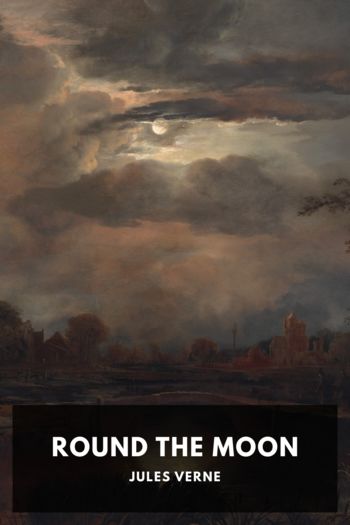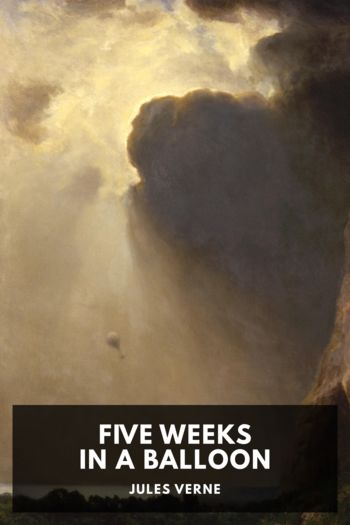From the Earth to the Moon, Jules Verne [beach books .TXT] 📗

- Author: Jules Verne
Book online «From the Earth to the Moon, Jules Verne [beach books .TXT] 📗». Author Jules Verne
The day following that upon which the works of masonry and casting were terminated, Barbicane set to work upon the interior mould; his object now was to raise in the centre of the well, with a coincident axis, a cylinder 900 feet high and nine in diameter, to exactly fill up the space reserved for the bore of the Columbiad. This cylinder was made of a mixture of clay and sand, with the addition of hay and straw. The space left between the mould and the masonry was to be filled with the molten metal, which would thus make the sides of the cannon six feet thick.
This cylinder, in order to have its equilibrium maintained, had to be consolidated with iron bands and fixed at intervals by means of cross-clamps fastened into the stone lining; after the casting these clamps would be lost in the block of metal, which would not be the worse for them.
This operation was completed on the 8th of July, and the casting was fixed for the 10th.
“The casting will be a fine ceremony,” said J. T. Maston to his friend Barbicane.
“Undoubtedly,” answered Barbicane, “but it will not be a public one!”
“What! you will not open the doors of the inclosure to all comers?”
“Certainly not; the casting of the Columbiad is a delicate, not to say a dangerous, operation, and I prefer that it should be done with closed doors. When the projectile is discharged you may have a public ceremony if you like, but till then, no!”
The president was right; the operation might be attended with unforeseen danger, which a large concourse of spectators would prevent being averted. It was necessary to preserve complete freedom of movement. No one was admitted into the inclosure except a delegation of members of the Gun Club who made the voyage to Tampa Town. Among them was the brisk Bilsby, Tom Hunter, Colonel Blomsberry, Major Elphinstone, General Morgan, and tutti quanti, to whom the casting of the Columbiad was a personal business. J. T. Maston constituted himself their cicerone; he did not excuse them any detail; he led them about everywhere, through the magazines, workshops, amongst the machines, and he forced them to visit the 1,200 furnaces one after the other. At the end of the 1,200th visit they were rather sick of it.
The casting was to take place precisely at twelve o’clock; the evening before each furnace had been charged with 114,000 lbs. of metal in bars disposed crossway to each other so that the warm air could circulate freely amongst them. Since early morning the 1,200 chimneys had been pouring forth volumes of flames into the atmosphere, and the soil was shaken convulsively. There were as many pounds of coal to be burnt as metal to be melted. There were, therefore, 68,000 tons of coal throwing up before the sun a thick curtain of black smoke.
The heat soon became unbearable in the circle of furnaces, the rambling of which resembled the rolling of thunder; powerful bellows added their continuous blasts, and saturated the incandescent furnaces with oxygen.
The operation of casting in order to succeed must be done rapidly. At a signal given by a cannon-shot each furnace was to pour out the liquid iron and to be entirely emptied.
These arrangements made, foremen and workmen awaited the preconcerted moment with impatience mixed with emotion. There was no longer anyone in the inclosure, and each superintendent took his place near the aperture of the run.
Barbicane and his colleagues, installed on a neighbouring eminence, assisted at the operation. Before them a cannon was planted ready to be fired as a sign from the engineer.
A few minutes before twelve the first drops of metal began to run; the reservoirs were gradually filled, and when the iron was all in a liquid state it was left quiet for some instants in order to facilitate the separation of foreign substances.
Twelve o’clock struck. The cannon was suddenly fired, and shot its flame into the air. Twelve hundred tapping-holes were opened simultaneously, and twelve hundred fiery serpents crept along twelve hundred troughs towards the central well, rolling in rings of fire. There they plunged with terrific noise down a depth of 900 feet. It was an exciting and magnificent spectacle. The ground trembled, whilst these waves of iron, throwing into the sky their clouds of smoke, evaporated at the same time the humidity of the mould, and hurled it upwards through the vent-holes of the masonry in the form of impenetrable vapour. These artificial clouds unrolled their thick spirals as they went up to a height of 3,000 feet into the air. Any Red Indian wandering upon the limits of the horizon might have believed in the formation of a new crater in the heart of Florida, and yet it was neither an irruption, nor a typhoon, nor a storm, nor a struggle of the elements, nor one of those terrible phenomena which Nature is capable of producing. No; man alone had produced those reddish vapours, those gigantic flames worthy of a volcano, those tremendous vibrations like the shock of an earthquake, those reverberations, rivals of hurricanes and storms, and it was his hand which hurled into an abyss, dug by himself, a whole Niagara of molten metal!
The ColumbiadHad the operation of casting succeeded? People





Comments (0)